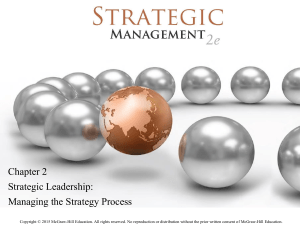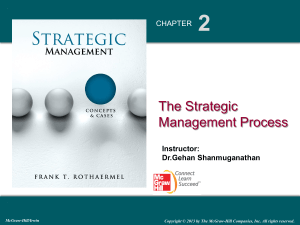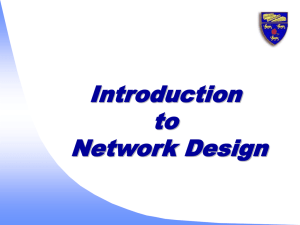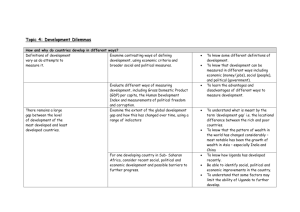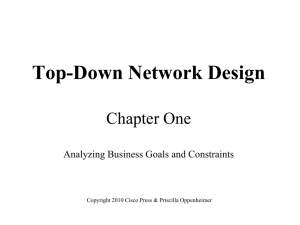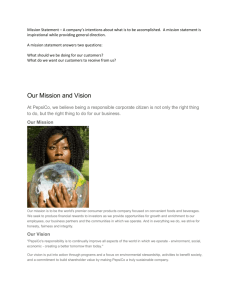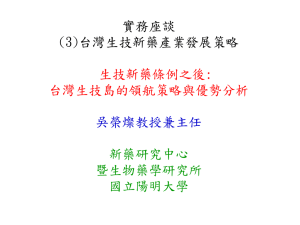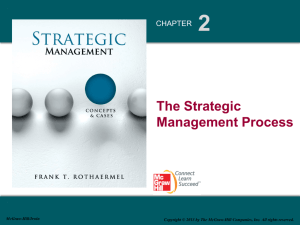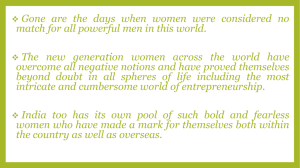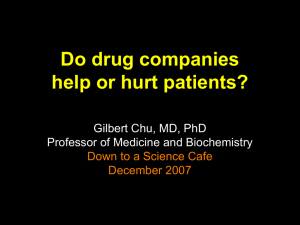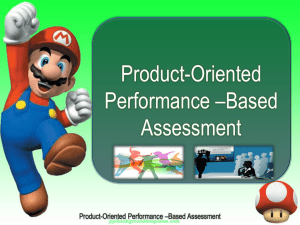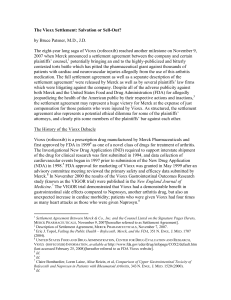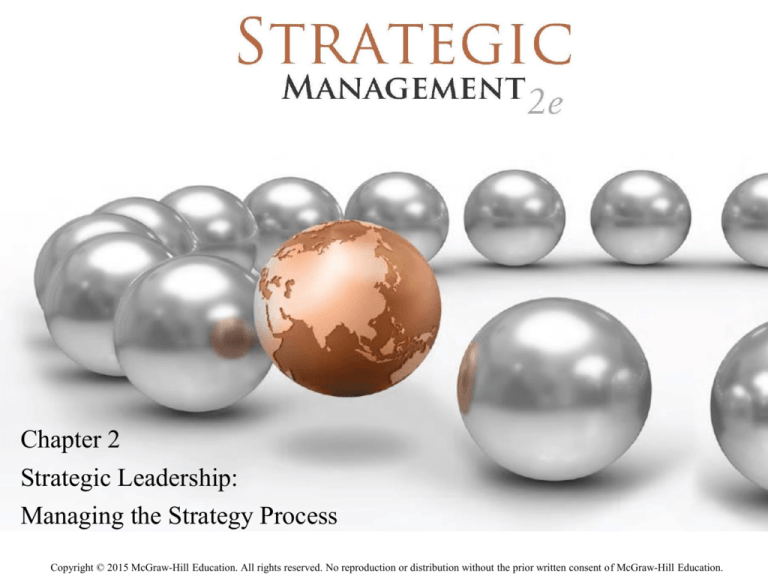
Chapter 2
Strategic Leadership:
Managing the Strategy Process
Copyright © 2015 McGraw-Hill Education. All rights reserved. No reproduction or distribution without the prior written consent of McGraw-Hill Education.
2-2
ChapterCase 2
Ms. Nooyi declared PepsiCo’s vision to be
“Performance with a Purpose,” defined by three
dimensions:
• Human sustainability
• Environmental sustainability
• The whole person at work
This triple-bottom-line competitive advantage approach
considers economic, social, and environmental
performance, underscoring CSR and stakeholder
strategy.
2-3
2.1 Vision, Mission, and Values
Strategic management process
Process employed by strategic leaders to conceive,
implement, and evaluate a strategy, which can lead to
sustainable competitive advantage
Strategic leadership
Executives’ use of power and influence to direct
assets in the pursuit of an organization’s goals
2-4
Vision and Mission
VISION
• Aspiration of the firm that lays the foundation for its
mission – “to” is a common word
MISSION
• What an organization does, including products, services,
and which markets – “by” is a common word
2-5
CUSTOMER-ORIENTED VS. PRODUCT-ORIENTED
Customer-oriented vision statements allow firms to
adapt to changing environments.
Product-oriented vision statements are less flexible.
Strategic flexibility is a necessary condition to
achieve competitive advantage.
2-6
Living the Values
Values are ethical standards/norms that govern the
behavior of individuals within a firm.
Two Important Functions:
1. Values form a foundation for a firm’s vision and
mission.
2. Values serve as the guardrails to keep the company on
track.
2-7
Strategy Highlight 2.1
Merck: Reconfirming Its Core Values
Founder George W. Merck’s words form the basis of
the company’s values even today.
Merck ended River Blindness in Africa, Latin America
& the Middle East by donating its recently discovered
drug Mectizan.
However, these values were challenged with the Vioxx
Case. The firm did voluntarily pull the drug off the
market when evidence linking heart attacks and strokes
to Vioxx was revealed,
Resulting in Merck shares falling 27%.
2-8
2.2 Strategic Leadership
ORGANIZATIONAL COMMITMENT
Strategic leadership – the behaviors and styles of
executives that influence others to achieve the
organization’s vision and mission
Strategic leaders impact firm performance as do
leaders whose decisions lead to huge destruction of
shareholder wealth and jobs.
2-9
Level 5 Effective Leaders
Capabilities
Level 5
CEO/TMT
Build greatness through
combination of will and
humility
Level 4: VPs
Can lead a group to superior
levels of performance
Level 3: Middle Managers
Organize people resources to
accomplish predetermined
objectives
Level 2: Team Members
Level 1: Lower Level Employees
Work effectively with others as a
member of a team to achieve
group objectives
Make individual contributions
through KSAs and work ethic
10
WHAT DOES IT TAKE TO BE A
CEO/Strategic Leader?
Charisma?
Integrity
An Ivy league
MBA?
International
management
experience?
There is little
consensus
on whether
personality or
background
matters more
11
Formulating Strategy Across Levels:
Corporate, Business, and Functional Managers
CORPORATE STRATEGY
• Where to compete (industry, markets, and geography)
BUSINESS STRATEGY
• How to compete (cost leadership, differentiation, or
integration)
FUNCTIONAL STRATEGY
• How to implement a business strategy
2-12
2.3 The Strategic Management
Process
When strategizing for competitive advantage, managers rely
on three different approaches. This order represents how
these approaches were developed over time.
STRATEGIC PLANNING
SCENARIO PLANNING
STRATEGY AS PLANNED EMERGENCE
2-13
Top-Down Strategic Planning
Top-down strategic planning – Rational, top-down
process aiding in programming for future success
Information flows only one way: top-down.
Centralized strategic intelligence and decision-making
Exhibit 2.6 illustrates the three steps of analysis,
formulation, and implementation in a traditional topdown strategic planning process.
2-14
Scenario Planning
Managers envision different what-if scenarios to
anticipate plausible futures.
Scenario planning takes place at both the corporate
and business levels of strategy.
Addresses both optimistic and pessimistic futures
Exhibit 2.7 illustrates the use of scenario planning
with the AFI strategy framework.
2-15
Strategy as Planned Emergence:
Top-Down and Bottom-Up
Critics of top-down and scenario planning argue that
strategic planning is not the same as strategic
thinking.
Most notable of these critics, Henry Mintzberg,
proposed a third approach to the strategic management
process.
From this viewpoint, managers must synthesize all
available input from different internal/external sources
into an overall strategic vision.
2-16
Strategy Highlight 2.2
Starbucks’s CEO: “It’s Not What We Do”
The story of Frappuccino® is chronicled in this Strategy
Highlight, including:
• The strong resistance by top executives
• The tenacious determination of one store manager, Diana
• The importance of a product champion for autonomous
innovation
• The culmination of Frappuccino being a billion-dollar
business for Starbucks
2-17
STRATEGIC INITIATIVES VIA AUTONOMOUS ACTIONS:
Championed by a mid-level engineer, GE’s leadership
relented and bought Enron Wind for $200 million.
A huge success, generating revenues over $10 billion in
2012, this acquisition opened up significant alternativeenergy opportunities, including GE’s ecomagination.
From product-oriented to consumer-oriented, from
Welch to Immelt, GE transitions are underscored.
2-18
2.4 Implications for the Strategist
TWO NECESSARY INGREDIENTS
To create a powerful foundation for strategy
formulation and implementation, the basis for
gaining and sustaining a competitive advantage:
• First, the firm needs an inspiring vision and mission
backed up by ethical values.
• Second, the firm needs an effective strategic management
process.
2-19
ChapterCase 2
© Neville Elder/Corbis
Consider This…
The stakeholder strategy approach adopted by Indra
Nooyi is applauded by some, yet performance under
PepsiCo’s “Performance with a Purpose” vision is
lagging behind Coke and Diet Coke.
Should Ms. Nooyi be replaced?
Should PepsiCo be split into a beverage and snack
foods company in order to leverage unbundled profit
potential?
2-20

